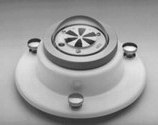Schenk Star pyranometer
 The Schenk
Star pyranometer is a black and white star type pyranometer that has six
black and six white segments. The temperature difference between the black
and white painted sectors is proportional to the incident solar radiation.
Because the measurement is a temperature difference, the measurement should
not be affected as much by ambient temperature.
The Schenk
Star pyranometer is a black and white star type pyranometer that has six
black and six white segments. The temperature difference between the black
and white painted sectors is proportional to the incident solar radiation.
Because the measurement is a temperature difference, the measurement should
not be affected as much by ambient temperature.Specifications
| • | Measuring range: 0 to 1500 Wm-2. |
| • | Spectral sensitivity: 0.3 to 3 µm. |
| • | Output: about 15 µV/Wm-2 or 4 to 20 µA for 0 to 1500 Wm-2. |
| • | Impedance: about 35 Ohms. |
| • | Ambient temperature: -40 to +60°C. |
| • | Resolution: < 1 Wm-2. |
| • | Stability: < 1 % per year (temporary operation) |
| • | Cosine response: < 3% of the value, zenith angle 0° to 80°. |
| • | Azimuth response: < 3% of the value. |
| • | Temperature effect: < 1 % of the value between -20 and +40°C. |
| • | Linearity: < 0.5% in the range 0.5 to 1330 Wm-2. |
| • | Response time: < 25 seconds (95%), < 45 seconds (99%). |
Accuracy
An Eppley PSP, which measures the temperature difference between a black disk and the body of the pyranometer, has an offset that results from the black disk radiating to the sky. This effect can be seen by the small negative irradiance values generated during the night. (This offset is on the order of 10 W/m2.)
© 2022, UO Solar Radiation Monitoring Laboratory.
|
Top of page Site map Solar data Instruments Publications |
Home page Search About our data Software tools |
Sponsors Contact us Monitoring stations Educational material |
Home page URL: solardata.uoregon.edu
